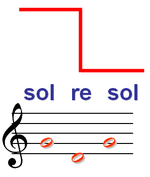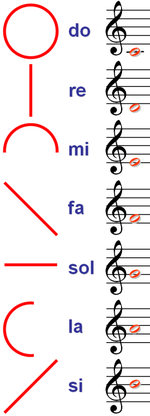Solresol
| Solresol | ||
|---|---|---|
| Project author | François Sudre | |
| Year of publication | from 1817 | |
| Linguistic classification |
||
| particularities | Language based on the notes of an octave | |
| Language codes | ||
| ISO 639 -1 |
- |
|
| ISO 639 -2 |
art (other constructed languages) |
|
Solresol (or la Langue Musicale Universelle ) is a planned language that was developed by the French (Jean) François Sudre from 1817. The language became popular with the publication of the Grammaire du Solresol by Boleslas Gajewski in 1902. Sudre wanted to create a world language on a musical basis. After forty years of preparatory work, he demonstrated his invention in public.
But Solresol has a cumbersome grammar, and its arbitrary vocabulary requires intensive memory training. It was quite popular for fifty years (although it was never put into practical use). A disadvantage is the a priori formed vocabulary, which offers the learner hardly any reference points to other, already known languages. In 1977 Steven Spielberg used Solresol in his film Close Encounters of the Third Kind based on the teachings of the Hungarian composer Zoltán Kodály .
Examples
The vocabulary is based on the tone syllables : do , re , mi , fa , sol , la , si (or ti ). Frequently used words consist of one, two or three syllables / notes, for example: si - "yes", do - "no", doredo - "time", dorela - "year", doresi - "century". More specific terms are made up of four or five syllables.
The special thing about Solresol is that you can communicate not only by speaking, but also by singing, whistling, with flutes or other musical instruments. You can write in letters, musical notation or your own Solresol syllable alphabet. The individual tone syllables can also be replaced by numbers ( do - 1, re - 2 ...), represented with different colors or hand signals or - particularly useful for communicating with the visually and hearing impaired at the same time - conveyed by pressing certain points on the other person's hand .
Similar to Ro, there are groups of words according to the meaning depending on the first syllables or musical notes. Words beginning with sol refer to art or science , and then it goes in depth, such as solsol for disease and medicine , etc.
To express the opposite, the syllables of the word are simply reversed: fala - "good", lafa - "bad".
- misol - "good"
- solmi - "bad"
- domisol - "God"
- solmido - "devil"

Common words used combinations of three notes:
- doredo - "time"
- doremi - "day"
- dorefa - "week"
- doresol - "month"
- dorela - "year"
- doresi - "century"
More than 11,700 words were possible through combinations.
- Example: Dore milasi domi. - "I love you."
Words can be changed by the accent:
- Redomido - "slander"
- RE domido - "defamation"
- Re DO mido - "slanderer"
- Redo MI do - "defamatory" (adjective)
- Redomi DO - "defamatory" (adverb)
In the Esperanto Museum and in the Collection for Planned Languages in Vienna, Solresol word and sentence examples can be heard over headphones.
advantages and disadvantages
An arbitrarily structured system has the advantage that it is internationally neutral. However, the terms are therefore also difficult to memorize. The grammatical function of the words in the sentence is easy to identify and there are only a few different characters to learn. They are flexible and can, for example, be based on sound for the blind and on characters for the deaf. However, the small number of characters requires great accuracy and does not allow redundancy .
At the end of the 19th century, new planned languages such as Volapük and Esperanto appeared, which were more successful, so that Solresol was almost forgotten in the 20th century. Nevertheless, to this day there is a small group of speakers who live all over the world and, above all, let the language live through the Internet.
Web links
- Literature on Solresol in the ONB's collection for planned languages
- Boleslas Gajewski: Grammar of the Solrésol Language, the universal language by François Sudre. University of Oviedo , December 14, 2003, archived from the original on March 29, 2008 .
- Boleslas Gajewski: Grammar of Solresol or the Universal Language of Francois Sudre. In: mozai.com. November 19, 1997 (English).
- A compilation of information about Solresol, the universal musical language (English)
Individual evidence
- ↑ James Peel: The Scale and the Spectrum: A history of color-music. In: Cabinet Magazine. 2006, accessed November 30, 2019 .

